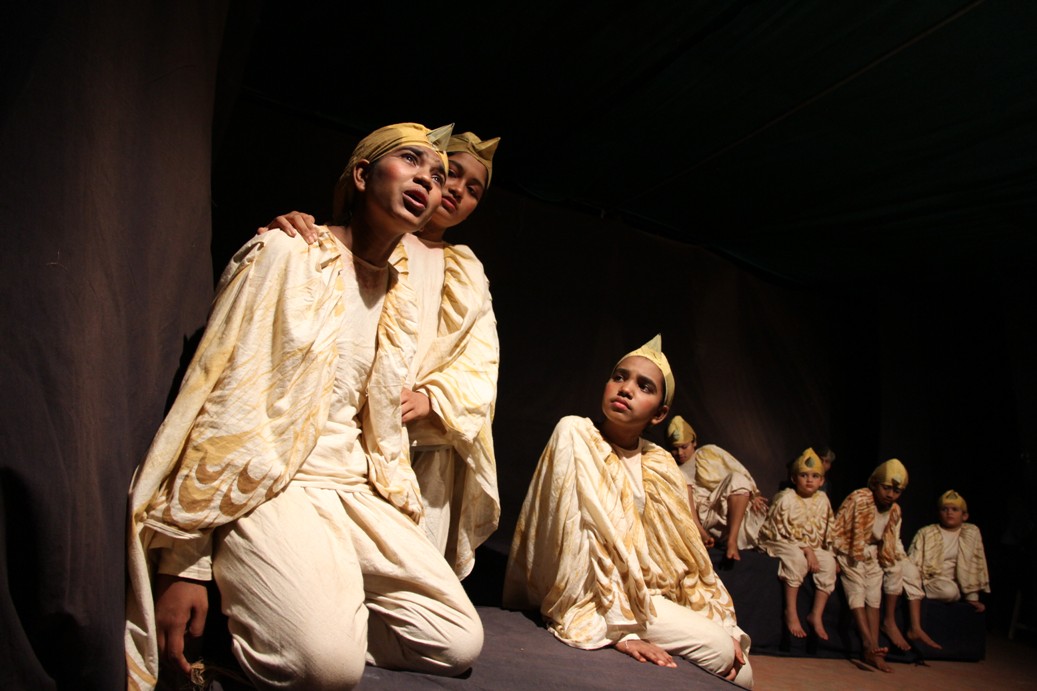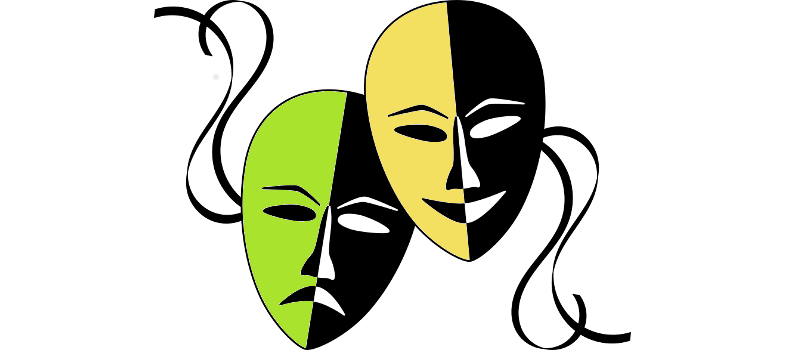The story and flow of events
A play is a continuous chain of interlinked events which make an interesting story!
Events and their flow
The six elements of the theatre
Aristotle in his Poetics, the book he wrote,
has mentioned the critical six elements of a play:
Action
Character
Thought
Language
Music
Spectacle
After about two thousand and five hundred years, nothing has changed, and he still holds! These are the main ingredients, essential to make the recipe of a play! He considered "a plot" or the series of actions or events, as a first element. The plot tells us what happens in a play.
So even if we know the idea or the subject for our proposed play we need to see the series of events taking place in a play or a storyline of a play. If we get this very early in our rehearsals, we have a chance to develop a play in a short period.
A plot is nearly a play
A plot works as a structure of a play on which we can place other things to get the final image. To let every participant know about the plot is suitable for their involvement in the thinking process. It is good to have a basic shared understanding of our play in every participant's mind. The plot gives them ground to play. Everyone starts thinking and tries his best to fit into the story. Imagining ourselves in a particular role is the beginning of a thrilling journey.
We have to think about how to make the storyline enjoyable and flawless. Knowing this well, we can weave our idea or thought in a plot. If we do not break the thought into actions, it won't be a play.
What happens in a play?
The action
People like to see a play to `happen' before them. They want to sit and witness actions. They do like the thought behind the story, but they are interested in getting it through a story or action and not in mere words.
Series of actions together in proper order, give the audience an experience of a play.
How to make a start?
Not every time the thought precedes; sometimes we have a story with us, and then we try to make it meaningful and try to introduce the idea through it.
Even characters can take the first place in the process of creating a play and make it compulsory for us to concentrate only on characters, and then we plan a storyline or a thought for those selected characters.
It may sound funny, but many times, I have just written names of participant students on paper and sat for hours thinking about the exciting roles they will get to play. Creating characters as per the availability of actors is not a proper way to proceed, but it does happen sometimes. We have to have the plot to suit those characters. Some plots we are not able to explore just because we don't get the right actors at that time.
Dear friends, staging a play is not a smooth game. There are many hurdles and hence alternate routes too. It depends on you to take the group forward with the available resources towards the best possible destination.
Creating the plot for `A LANDSCAPE.’
Care for nature
The thought in the play `A LANDSCAPE' is ` care for the environment '! Creating the story for this idea was the next most crucial thing to be done. We did many discussions and then finally we had some three or four stories and two or three types of styles of plays with us. The thought about caring nature was handled so many times in the past that it was not at all a new thing we were telling people. But some ideas we need to stress again and again.
This time birds attracted us and occupied the center stage of our minds. There is no doubt that our behavior with nature requires serious thinking. The way children all over the world are protesting for environmental issues is not unnatural. It is the need of time.
The bird family
As I stated before the family of the birds staying near us was one of the reasons to take this topic. We decided to project their lifestyle for all. It was quite engaging when we did in improvisation. Two senior actresses in our group Bhagyashree and Srushtee played the father and mother bird, respectively. Three Children by Swara, Sanchi, and Mahi. Their life in the nest, feeding young ones, their sleep pattern, knowing about day and night, their love, affection, and fears, everything was presented by them through their discussions. We took that as the base and then arranged other stories step by step.
Learning to fly was a real joy!
The darker side /the real content

The entry of crows, a natural threat was the beginning of dangers ahead. Then all the troubles came one after the other. Fire-crackers, Insecticides sprays, deforestation, fire in the forest and then the mining hazards followed to state the degree of destruction of the landscape.
Except for the crows, all other troubles are human-made. The development of the human race is creating a real threat to nature. Birds being delicate are more vulnerable. Species getting lost one by one is a worrisome picture. The conflict in the play is definitely between the birds and the human race.
The human family
It was necessary to have another side of the story too, and to give a chance to the positive side; we created the protagonist family in the play. It also helped us to paint the problems of urbanization through them. The first scene kept the suspense about the entry of birds. It was good to see them after a brief introduction.
Connecting the two families
We had two plots here. One of a human family and then another of a bird family. These two plots we developed together and then juxtaposed them. It was fascinating to see the characters developing one by one in the story. Two stories getting shaped simultaneously and getting connected at the end was the final structure of the play.
To end the story was the difficult most part. But the way it ends leaves a ray of hope for the coming generations of birds and the humans too.
The realistic style
The story had characters which were from real life, and the story narrated was not an imaginary one. We kept the form of the play as a realistic one. The subject is serious and getting more severe towards the end; we preferred not to go away from the theme. No scene was introduced just for the sake of entertainment.
The flow of events
We have presented the story in a simple chronological order. That means in the same order as the events took place in real life. So we proceeded from the past to the present — a linear presentation.
Here people witness everything in the present tense on stage, and they are almost there with the characters to live with them and to share all the emotions with the same intensity as those of the characters. The real beauty of the theatre!
People start getting involved with the characters once they identify them with the help of their appearance, their actions, their reactions, their dialogues, and their intentions. The story moves with the actions. Characters say something and push the story ahead. With every moment on stage, people have something getting processed in their mind. For every action on stage, there is a reaction in the mind of the audience.
The flow of events happens at two places, on stage, and in the minds of the audience.
Action and the audience
Action is not necessarily a gross physical movement or a stylish dialogue or a scene of a certain length.
Action is read or understood or felt by the audience with the mere simple word or minute reaction or a particular look given by the character.
The audience is like a scientist looking through the microscope. The audience misses hardly anything. Not a sound, not a line the audience misses. The performing team should never forget this fact that no one can ever cheat any audience.
